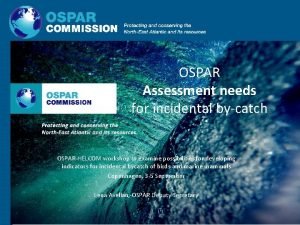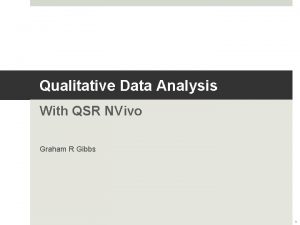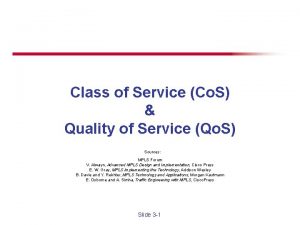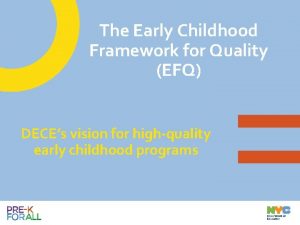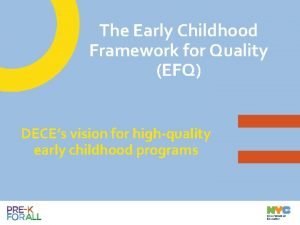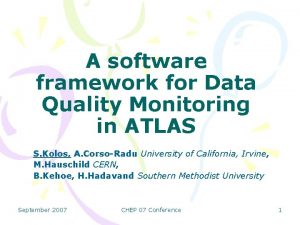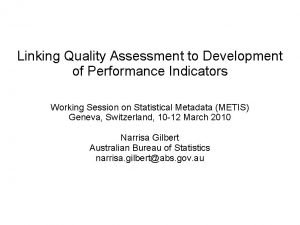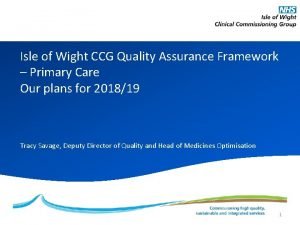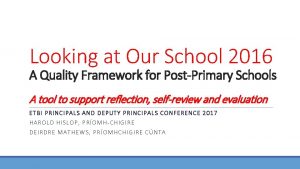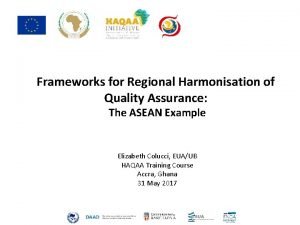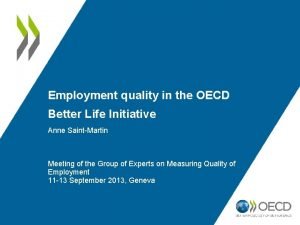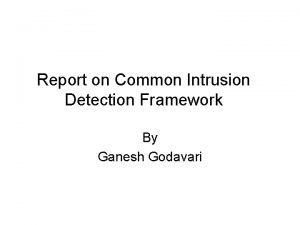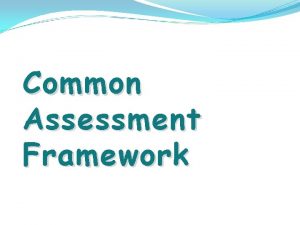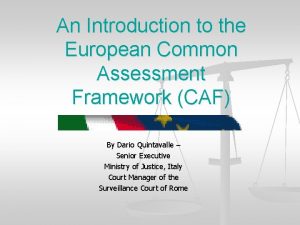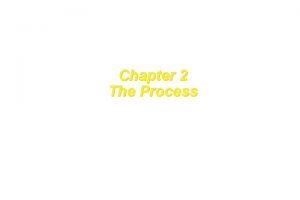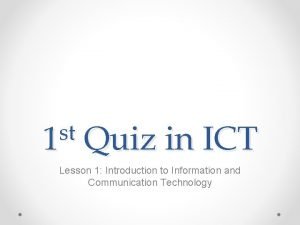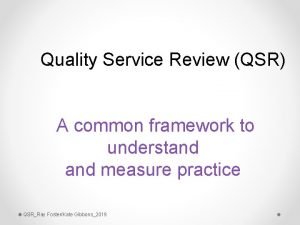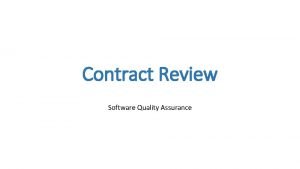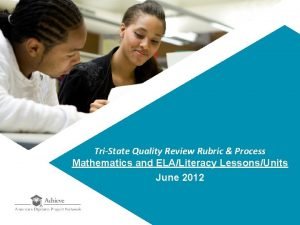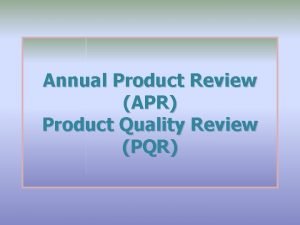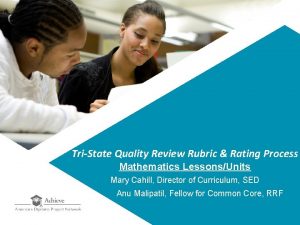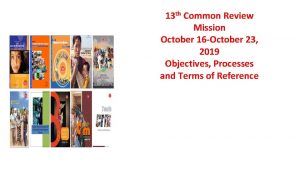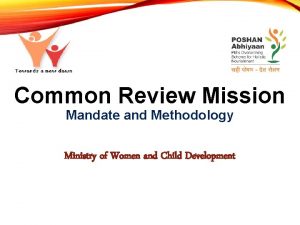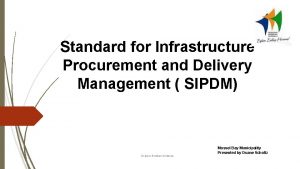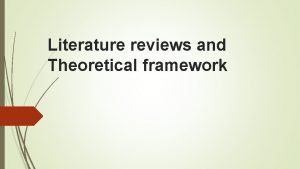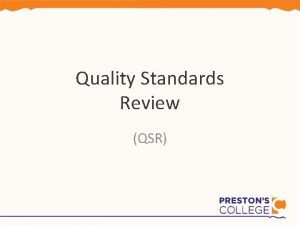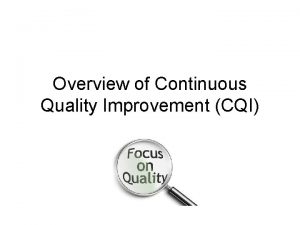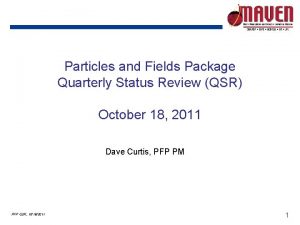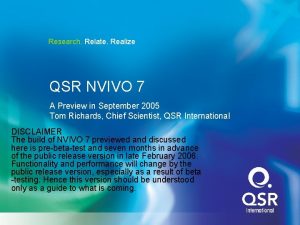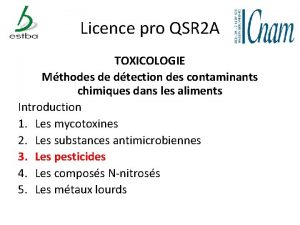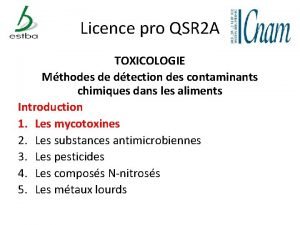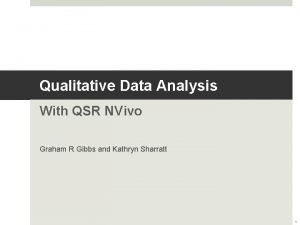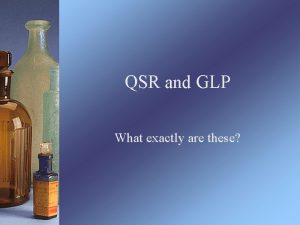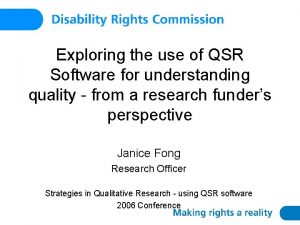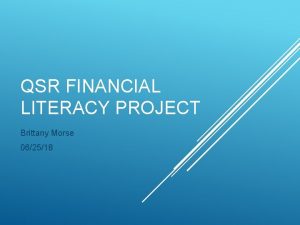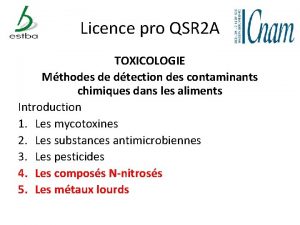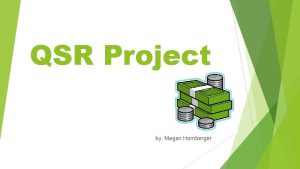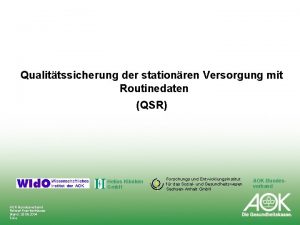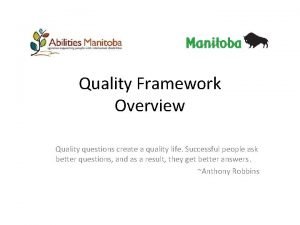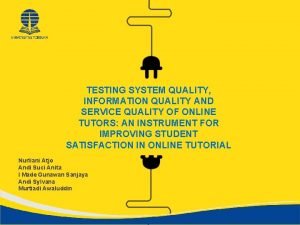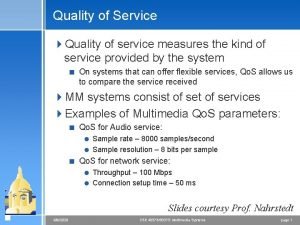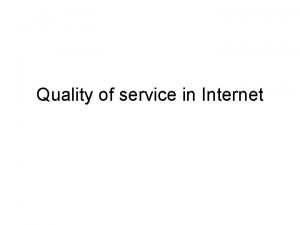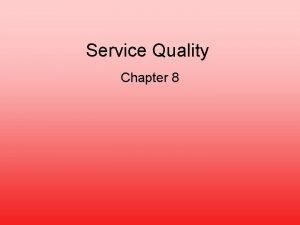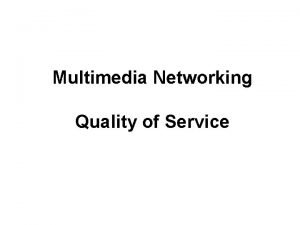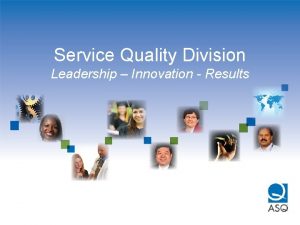Quality Service Review QSR A common framework to





















































- Slides: 53

Quality Service Review (QSR) A common framework to understand measure practice QSR_Ray Foster/Kate Gibbons_2019

What is QSR? Introduction to QSR Concepts QSR_Ray Foster/Kate Gibbons_2019

What QSR is NOT Is NOT a compliance-based audit Is NOT a job performance review Is NOT evaluation of evidence-based practice Is NOT looking for what you are doing wrong

What is QSR? • The Quality Service Review (QSR) is a way of knowing what’s working and why. • QSR measures how well teams are adhering to the practice model. • QSR provides quantitative and qualitative information to describe practice and performance of the system. • QSR is a teaching process that clarifies expectations, provides feedback, and stimulates thinking and next step actions to improve practice and results. QSR_Ray Foster/Kate Gibbons_2019

Your VANTAGE POINT Determines What You SEE Chart Audit = QSR = 15 -degree 360 -degree Key Hole Big Picture View focused on Record-Based COMPLIANCE View focused on Person-Centered PRACTICE QSR_Ray Foster/Kate Gibbons_2019

How Does QSR Work? • Uses in-depth CASE REVIEWS of records and interviews to measure current status, recent progress, and adequacy of current practices in getting results for youth being served. • Uses STORY-BASED LEARNING & TEACHING to understand what is happening and working for youth. • Uses aggregate quantitative PATTERNS of qualitative indicators to reveal and describe the quality and consistency of practice. • Uses immediate FEEDBACK to those providing services along with case stories, data patterns, and local working conditions to find affirm what’s working now and to identify areas where even better results might be QSR_Ray Foster/Kate Gibbons_2019 achieved in the future.

How Staff Should Perceive QSR Experiences FAIR SAFE Staffs’ Lived Experiences with QSR Activities RESPECTF UL QSR_Ray Foster/Kate Gibbons_2019 HELPFU L

Strengthening Our Practice to Improve Our Results Using the Quality Service Review to Guide Practice Development QSR_Ray Foster/Kate Gibbons_2019

Commonality of Purpose • We are partners in a community of practice • We are here to help local partners succeed • We will address matters at each level of organization that affect delivery of services • We focus on our practice and results • We bring opportunities and problem QSR_Ray Foster/Kate Gibbons_2019

SAFE => Shifting from Blaming to Learning • From: Blame the Worker INDIVIDUAL: Let’s find-out • To: Improve the SYSTEM: System Let’s find things in who screwed-up, “ding’em, ” our system that increase require Corrective Action problems, reduce good results Plans! • PROBLEM FOCUS: • PERSON FOCUS: – What happened here? – Who did it? • PERFORMANCE: – What you did was wrong! – Let’s see what we can do to get the results we want! • PUNISHMENT: – It’s your fault! [GOT YA!] • OPENNESS & SAFE LEARNING: • COVER-UP FEAR = NO – We want to learn more LEARNING: about this problem so that – I won’t reveal my mistakes. we can do better in the near – Foster/Kate It’s not. Gibbons_2019 worth it to try new future. QSR_Ray ideas.

QSR_Ray Foster/Kate Gibbons_2019

What is Practice? • Practice consists of the things we do to help a person in need to get better, do better, and stay better in life. • Practice involves conceptualizing, organizing, and providing interventions that change lives. • Effective practice depends on practical wisdom and smart problem solving to get good results. QSR_Ray Foster/Kate Gibbons_2019

Why Do Practice? • PURPOSE OF PRACTICE -- helping a person having disruptive life needs and/or threats of harm to achieve and maintain adequate levels of: [Important Outcomes] – Well-Being (health, mental health, safety, stability, sobriety, etc. ) – Supports for Living (having housing, income, health care, childcare, transportation necessary for daily living and normal functioning) – Daily Functioning (performing age-appropriate tasks necessary for successful daily living in normal settings) – Fulfillment of Key Life Roles (a youth being a successful QSR_Ray Foster/Kate Gibbons_2019 student and an adult being a successful parent, employee, and citizen)

What is Integrated Care? • Recognition that physical and mental health interact to impact overall health of the person • Coordination of physical and mental health services & both aspects given equal attention • Primary care staff, behavioral health staff and the person/family work together - Based upon their desires, goals and existing strengths Find strategies for improving overall health Using a systematic and cost effective approach Improving ineffective patterns of health care utilization QSR_Ray Foster/Kate Gibbons_2019

Purpose of Integrated Care • The Purpose of Integrated Cares is to… o Improve the overall wellness and physical health status of people with mental health issues and/or cooccurring substance use disorders… o By supporting the coordination and collaboration of mental health treatment with primary care and preventive physical health services. QSR_Ray Foster/Kate Gibbons_2019

Differences Between Modes of Care Primary Heath Care • • • Behavioral Health Care • Firm boundaries • Professional distance & neutrality • Consistent roles • Info is private & confidential • Tx within context of relationship • Treat & terminate (close chart when treatment episode ends) • Individualized treatment planning QSR_Ray Foster/Kate Gibbons_2019 • Recovery model / Flexible boundaries Empathy & compassion Shifting roles Info shared between staff Tx based on external data Brief encounters over a long time (never close chart) • Use of clinical guidelines to plan tx • Disease management • Sees role as fixing the problem

QSR_Ray Foster/Kate Gibbons_2019

Conditions of Practice Organizational Supports, Working Conditions, Craft Knowledge, Results QSR_Ray Foster/Kate Gibbons_2019

These Elements Should Work Together Operational Structures Approaches & Techniques • Policies & procedures • Integrated care model • Funding requirements • Wellness & recovery • Programs & services • Person-centered, strengths-based, solution-focused practice • Facilities, agency infrastructure, resources • Evidence-based practices (FFT, CBT, etc) • HR & staffing patterns • Screening tools & structured decisionmaking protocols • Compliance enforcement • QSR_Ray Organizational Foster/Kate Gibbons_2019 climate, culture, staff Craft Knowledge & Clinical Reasoning • Performance of basic practice functions • Worker craft knowledge & level of autonomy • Situation understanding, clinical grasp, foresight, reasoning, case formulation, action logic • Link: conditions results

Framing Practice Expectations Person, Child, Family In Need 1. Engaging Service Partners 2. Understanding The Situation 4. Implementing Services 3. Planning Life Changes & Interventions 5. Getting & Using Results QSR_Ray Foster/Kate Gibbons_2019 Outcomes Met for Case Closure

• Keys to Successful Frontline Practice • Motivation Craft knowledge • Practical wisdom • Mentoring • Coaching • • Skill Will Mean s Team s • Clinical support • Working conditions • Autonomy • Common purpose • Unity of effort • Collaboration & coordination Opportunity Organization Resources Leadership QSR_Ray Foster/Kate Gibbons_2019

What is the QSR Designed to Measure & • PERSON’S STATUS: relative to well-being, Improve? key supports, adequate daily functioning, Person’s Situation System’s Response Results performing necessary life roles [essential for daily living] • PERSON’S NEEDS: unmet, essential, qualifying • • SYSTEM ENTRY CRITERIA met PRACTICE MODEL: Engagement, teamwork, assessment, planning, implementation, tracking • BUSINESS MODEL*: Eligibility, access, funding, process requirements, infrastructure support (training, supervision, caseload, time demands, • IT PERSON’S NEEDS being reduced support, flexible resources, etc. ) or met • PROGRESS being made toward outcomes • OUTCOMES attained and/or maintained • SYSTEM EXIT CRITERIA met * QSR reveals the extent to which the Business Model supports the Practice required for the Person Served QSR_Ray Foster/Kate Gibbons_2019

Functions QSR Tests Basic Practice Functions QSR_Ray Foster/Kate Gibbons_2019

QSR is the Engine of Change • Ways to Drive Practice Change: o Frequent new learning about: child/family/adult status, case practice, recent results, local conditions of practice o Well-used positive feedback loops o Action teams putting new learning to work to advance practice QSR_Ray Foster/Kate Gibbons_2019 o Advances in the “practice The “Engine of Change” Requires Leadership To Drive the Process

QSR: Focus on Practice & Results Status of Person Practice & Performance How is the focus person served Doing on key status indicators? How well are practices working for person served? Recent Results Frontline Conditions Is the person served showing Progress towards meeting planned Results and Outcomes? How are frontline working Conditions affecting practice, Performance, and results? QSR FINDINGS ARE USED FOR LEARNING & CHANGE Findings are used to decide: WHERE ARE WE NOW? • WHAT TO DO NEXT? QSR_Ray Foster/Kate Gibbons_2019

QSR Components Structure of the Model and Reviews QSR_Ray Foster/Kate Gibbons_2019

How Does QSR Work? • Uses in-depth CASE REVIEWS to measure a person’s status, recent progress, and adequacy of current practices. [Drill Downs] • Applies STORY-BASED LEARNING & TEACHING to understand what is happening and working for a person. [Stories Teach] • Explores aggregate PATTERNS of qualitative indicators to reveal and describe the quality and consistency of local practice. • Combines FOCUS GROUP / KEY STAKEHOLDER INTERVIEWS along with case stories, data patterns, and local working conditions to find CHALLENGES & QSR_Ray Foster/Kate Gibbons_2019 OPPORTUNITIES.

Functions QSR Tests Basic Practice Functions QSR_Ray Foster/Kate Gibbons_2019

How Staff Should Perceive QSR Experiences FAIR SAFE Staffs’ Lived Experiences with QSR Activities RESPECTF UL QSR_Ray Foster/Kate Gibbons_2019 HELPFU L

The QSR Protocol • Functions as a GUIDE BOOK for focusing reviews • Provides qualitative indicators with fact patterns • Provides rating scales for indicators • Sets time windows for reviewing • Provides a BASIS for the: – DATA PROFILE or “roll-up sheet” – ORAL REPORT made a debriefing – WRITTEN REPORT of findings QSR_Ray Foster/Kate Gibbons_2019 – NEXT STEP PLANNING

QSR Status & Practice Indicators Measures of the Person’s Status to harm • Safety * – exposure • Safety * – behavioral risk • Physical health • Emotional/mental health • Substance use status • Spiritual well-being • Functional status • Voice & choice/self-directed care • Economic security/personal mgt • Living situation • Social supports • Learning/development • Work status • Parenting/caregiver functioning Measures of Practice Performance • Recognition, connection, rapport • Engagement & commitment • Care coordination & teamwork • Screening, detection, mitigation, monitoring • Assessment & case formulation • Wellness & recovery goals • Planning interventions • Delivering interventions • Medication management • Situation, tracking, adjusting, transitioning QSR_Ray Foster/Kate Gibbons_2019

QSR Indicators & Rating Windows STATUS PRACTICE Indicators (past 30 days) (past 90 days) QSR_Ray Foster/Kate Gibbons_2019 PROGNOSI S Indicator (next 180 days)

How to Apply a QSR Indicator 1. Know the Indicator 2. Get the Facts 3. Connect the Dots 4. Recognize the Pattern 5. Rate the Pattern QSR_Ray Foster/Kate Gibbons_2019 4

QSR_Ray Foster/Kate Gibbons_2019

About Ratings of 3 & 4 3 -4 • Rating of 3 = Unacceptable: – A rating of 3 is marginal, but not presently acceptable. – A rating of 3 is not adequate for the person to do well now or in the near-term future. – A rating of 3 may show some positive indications, but now falls short of a desired result or adequate function. • Rating of 4 = Acceptable Now: – A rating of 4 is minimally acceptable right now. – A rating of 4 is just enough for the person to do OK now and in the near-term future. – A rating of 4 requires sufficient evidence of currently acceptable status or adequate practice. – Remember the “Groundhog Rule: ” If we continue doing what we are doing, will the person achieve desired QSR_Ray Foster/Kate Gibbons_2019 – Under favorable outcomes? conditions a 3 could

QSR 4 -Day Onsite Schedule Off-Site QSR Reviewer Training Focus Group Interviews/ Stakeholder Interviews Day 1: Case 1 Orientation to the agency Conduct QSR Data collection & Analysis activities Day 2: Case 2 Conduct QSR Data collection & Analysis activities Day 3: Case 3 Conduct QSR Data collection & Analysis activities Day 4: QSR Case Feedback, Sum-Up Session, Plan Next Steps Aggregate Results, Patterns, Findings, Recommendations QSR_Ray Foster/Kate Gibbons_2019 Next Step Planning - using QSR findings and

QSR Products Learning, Data, Quality, CQI QSR_Ray Foster/Kate Gibbons_2019

QSR_Ray Foster/Kate Gibbons_2019

QSR_Ray Foster/Kate Gibbons_2019

QSR_Ray Foster/Kate Gibbons_2019

QSR_Ray Foster/Kate Gibbons_2019

QSR_Ray Foster/Kate Gibbons_2019

QSR_Ray Foster/Kate Gibbons_2019

QSR_Ray Foster/Kate Gibbons_2019

Hawaii System Change Pattern Sustainabili ty QSR Tracking Interim QSR Change Data Baseline QSR Data QSR_Ray Foster/Kate Gibbons_2019

QSR “Learning Products” STORIES of practice and results with persons served Recurrent TRENDS/THEMES observed across the review sample UNDERSTANDING of how contextual factors are affecting conditions of frontline practice and current results DATA DISPLAYS of the persons’ status and practice performance results, based on key measures Highlight ACCOMPLISHMENTS & SUCCESSES Identification of challenges & opportunities for NEW QSR_Ray Foster/Kate Gibbons_2019

QSR is the Engine of Change • Ways to Drive Practice Change: o Frequent new learning about: child/family/adult status, case practice, recent results, local conditions of practice o Well-used positive feedback loops o Action teams putting new learning to work to advance practice QSR_Ray Foster/Kate Gibbons_2019 o Advances in the “practice The “Engine of Change” Requires Leadership To Drive the Process

QSR - Ways of Knowing & Doing QSR is an ORGANIZATIONAL LEARNING PROCESS. QSR observes the PRACTICE MODEL used in actual cases. QSR connects RESULTS to CONDITIONS OF PRACTICE. QSR supports TEACHING & LEARNING PROCESSES that clarify expectations, provide useful feedback, affirm good work. QSR supports EXPLORATORY ANALYSES and stimulates NEXTQSR_Ray STEP ACTIONS taken to improve Foster/Kate Gibbons_2019 practice and results.

Using QSR Tools & Results QSR Protocol & Job Aids • Using QSR results in a strategic leadership process for stimulating system change Teaching practitioners • Looking behind the basic craft knowledge of numbers to discover practice functions underlying causes of performance problems Reviewing practice • Helping leaders performance understand improve Identifying areas for the quality of practice via targeted training, affirmation and supervision, and reflective improvement practice strategies Supervising frontline staff • Providing training, for building high quality mentoring, and coaching practice of frontline practice Reviewing effectiveness of • Measuring change for treatment and supports affirmation and next step QSR_Ray Foster/Kate Gibbons_2019 actions • Teaching rapid assessment techniques to frontline staff • • • QSR Review Results

Stages of Craft Knowledge Development Stage Description of Stage Novice Has a beginning awareness, simple understandings; follows rules and forms; can’t recognize a problem well enough to diagnose it [Doesn’t know what he doesn’t know] Advance d Beginner Can perform in simple situations; acknowledges lack of knowledge; reliably follows steps that match familiar situations that have been studied [Easily overwhelmed by complexity and fear of failure] Compete nt Learner Exposed to the full array of knowledge; can work beyond the rules; adapts skills to new circumstances; may know what - but may still lack know how [Comfortable with practice skills and situations; may loose big picture amid details; learns from errors] Proficient Has engrained skills via continuing practice in diverse situations; Practitio reliably meets situations using a full range of strategies with a full grasp of the whole problem; still acts a conscious level [Competent and ner confident. Learns from atypical cases] Works beyond the rules to surpass the goals; fully internalized practice; works in the flow, adjusts as she goes; relies on pattern recognition & Adapted from The Dance of Change by Peter Senge, et. Al. , Doubleday, 1999 intuition [Seeks out cases involving novelty, risk, complexity to hone QSR_Ray Foster/Kate Gibbons_2019 problem-solving skills to teach others] Expert

What You Get from QSR Person-Based Teaching Stories Performance Results For Practice Indicators Respectful & Helpful Feedback Local Practice Conditions & Patterns Next Step Action Planning Practice Improvements QSR_Ray Foster/Kate Gibbons_2019

A Path to Better Results Excellence is never an accident. It is always the result of high intention, determined effort, and skilled execution. - Chinese Proverb QSR_Ray Foster/Kate Gibbons_2019

Questions and Comments
 Ospar qsr
Ospar qsr Interpace spatial genomics
Interpace spatial genomics Essnet qsr
Essnet qsr Qsr nvivo
Qsr nvivo Rome famous landmarks
Rome famous landmarks Mpls class of service
Mpls class of service Perform quality assurance
Perform quality assurance Plan quality management pmp
Plan quality management pmp Quality metrics pmp
Quality metrics pmp Quality assurance model in nursing
Quality assurance model in nursing Quality improvement vs quality assurance
Quality improvement vs quality assurance Quality control concepts
Quality control concepts Gurus of total quality management
Gurus of total quality management Quality is free
Quality is free Old quality vs new quality
Old quality vs new quality Greatest common factor of 18 and 27
Greatest common factor of 18 and 27 Common anode and common cathode
Common anode and common cathode Lowest common multiple factor tree
Lowest common multiple factor tree Factors of 54
Factors of 54 Lcm of 10 and 18
Lcm of 10 and 18 Highest common factors and lowest common multiples
Highest common factors and lowest common multiples Elof standards nyc
Elof standards nyc Early childhood framework for quality
Early childhood framework for quality Quality 2020 attributes framework
Quality 2020 attributes framework Dqmf
Dqmf Nche quality assurance framework
Nche quality assurance framework Abs data quality framework
Abs data quality framework The isle quality assurance
The isle quality assurance Looking at our school 2016 a quality framework
Looking at our school 2016 a quality framework Asean quality assurance framework
Asean quality assurance framework Oecd better life initiative
Oecd better life initiative Common intrusion detection framework
Common intrusion detection framework Common security advisory framework
Common security advisory framework Who needs a caf number
Who needs a caf number Common assessment framework 2020
Common assessment framework 2020 Common process framework in software engineering
Common process framework in software engineering It provides a common framework to allow data to be shared
It provides a common framework to allow data to be shared Common framework
Common framework Dispositional framework vs regulatory framework
Dispositional framework vs regulatory framework Sample of theoretical framework
Sample of theoretical framework Franmework
Franmework Conceptual framework theoretical framework
Conceptual framework theoretical framework Dispositional framework vs regulatory framework
Dispositional framework vs regulatory framework Theoretical framework example
Theoretical framework example #1 contract review software
#1 contract review software Quality review rubric
Quality review rubric Annual product quality review report
Annual product quality review report Quality review rubric
Quality review rubric Common review mission
Common review mission Common review mission
Common review mission Sipdm gate review framework
Sipdm gate review framework Theoretical literature review
Theoretical literature review Chapter review motion part a vocabulary review answer key
Chapter review motion part a vocabulary review answer key Writ of certiorari ap gov example
Writ of certiorari ap gov example
